The USN last onboard floatplane

The Curtiss SC Seahawk was a scout seaplane designed by Curtiss (Curtiss Aeroplane and Motor Co.) for the United States Navy during World War II. It was scheduled to replace the existing Curtiss SO3C Seamew and Vought OS2U Kingfisher by 1944 and postwar. Due to better radars, its postwar service was limited to just a few years, and most were gone by 1949. The paradox was the Seahawk somewhat redeemed Curtiss for its failures in wartime, between the execrable SB2C Helldiver, and catastrophically mediocre SO3C Seamew, whereas its land-based P40 Warhawk was soon eclipsed by better models or the Curtiss C-46 Commando not stellar either… Unfortunately for Curtiss, the Seahwak arrived too late, in short numbers, in a rather unsavioury role and never put under the light of projectors, as well as soon discarded when the concept itself past its prime. The company disappeared soon, after being at the forefront of US aviation history for decades. Now how good was the SC Seahawk and how it performed ? Let’s dive into it. #usnavy #curtiss #curtissseahawk #seaplane #floatplane #scoutplane #artilleryspotter #unitedstatesnavy #observationseaplane
Development
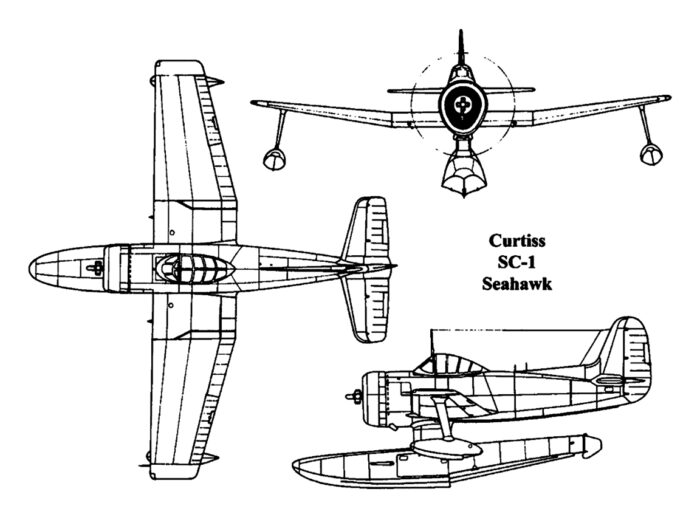
Work started in June 1942, after an US Navy Bureau of Aeronautics request for various observation seaplane proposals. Curtiss submitted it Seahawk design on 1 August 1942, a bit unusual as unlike most models of that type this was a single seat, high performances model. Navigation and radio technologies were such that it was bet by Curtiss that a single pilot could do the job. A single crew had many advantages, notably a more compact and performing seaplane, which was ideal to flee potential fighters.
Reviews of its blueprint were rather favourable, since the Navy did not obliged the adoption of a multiple sater model, imposed better performances as before, and to be usable both for reconnaissance and gunnery spotting, catapulted from battleships and cruisers.
Curtiss pressed the case to the Navy to look at its design and recalled the fiasco that was the Seamew, mostly because of the Navy insistence on a certain type of inline engine against adviced from the company. The Seamew was so disappointing in service the much older Curtiss SOC Seagull it was supposed to replace was recalled to replace the Seamew as interim ! The Kingfisher then became standard.
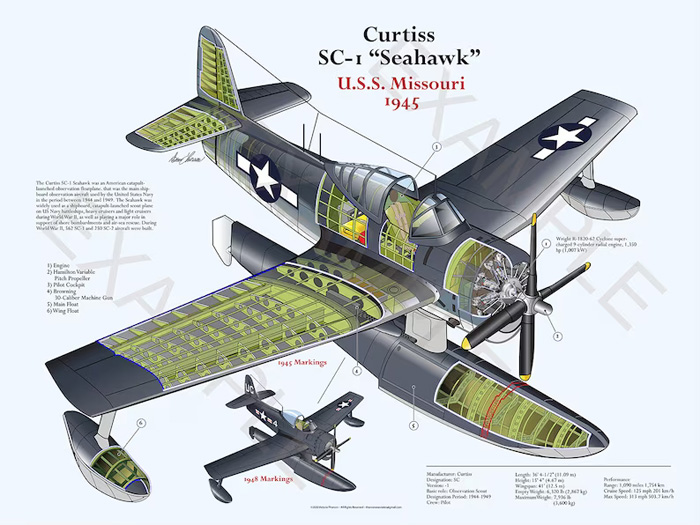
Cutaway artwork by Donn Thorson, purchase the poster here
Curtiss thus advocated for the choice a trusted, powerful radial engine: The Wright R-1820-62 Cyclone radial. With it, the single seat bird was to largely outperform not only its predecessors but also contemporaries in all key performance parameters, top speed, altitude, climb rate, payload or handling. With 1,350 horsepower and a lightweight, compact design, it became possible.
This choice of engine enabled notably a top speed of 313 miles per hour (500 kph). To compare, the Kingfisher was capable at best of 171 mph (275 km/h, 149 kn) at 5,000 ft (1,524 m), so the SC was simply twice as fast. Impressed by what was on paper, the Navy procurement bureau signed a contract awarded for two prototypes, and five service test aircraft on 25 August 1942. Although sources differed on this. A letter of intent was issued indeed on 30 October 1942 but the contract for two XSC-1 prototypes was only issued by 31 March 1943 for others.
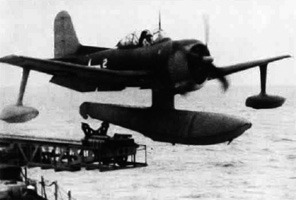 The prototypes were still not ready to tested in front of officials when a contract for 500 production aircraft was signed by the Navy in June 1943, before a single prototype was airbone.
The prototypes were still not ready to tested in front of officials when a contract for 500 production aircraft was signed by the Navy in June 1943, before a single prototype was airbone.
This production order for 500 SC-1s was also annouced as a first batch as the model was supposed to replace ALL existing seaplanes of this type, including the Kingfisher, not only on ships, but naval stations as well and be detached in seaplane bases across the Pacific.
The first flight of a prototype took place on 16 February 1944 at the Columbus (Ohio) plant and it went on until 28 April, just as the last of seven pre-production models arrived to be tested in turn, and then nine more prototypes tested with a second seat and modified cockpit as trainers, designated SC-2 but production was not approved. The very long development time and testing time proved an hinderance on the long run as the model arrived a bit too late to make an impression, but at the time Curtiss’s reputation was seriously damage and the staff wanted its bird as irreprochable as possible overall.

SC-1 wings folded, outer wing floats removed on a chariot, Naval Base (unknown date and location), from pinterest. Note the way the Browning HMGs were attached below the inner wings section.
Production went on at the Ohio facility from May 1943 to August 1945, terminated by Navy’s request as the war ended. In all, 577 were made, including the 500 order, plus numerous prototypes, SC-1 and SC-2 and the start of a new order, this time for 950 aircraft, but later decreased to 566 aircraft because of the Victory in the Pacific. However some data indicates that 112 Seahawks were delivered in 1944, another 444 in 1945, for a total of 568 aircraft (serials 119529 to 119538). The difference is explained by the prototypes and SC-2 again. They were ferried to Naval bases where the floats were attached, and then dispatched to their respective units attached to various cruisers and battleships, which had to wait before these came to the US for a refit or overhaul. Typical flights (VP) were made of three planes, the capacity of a cruiser/battleship.
Design
After the powerful engine, Curtiss added an airframe design that was also innovative, with a sleek, streamlined shape. The design of its pontoons necessary for water landings, a large ventral one and two smaller undering ones, was refined in wind tunnel until the drag they caused was reduced as much as practicable for floatability. But Curtiss had another impressive trick: Not only the underwings floats were retractable to reduce drag during flight, but the main pontoon could be jettisoned in an emergency. Both were also brand new features that had the Navy interested.
In terms of armament it was not a fighter and thus only had the minimum, two forward-firing Browning 0.5-in cal. Heavy Machine Guns (12.7mm) in the wings. But it could also carry two 100lb bombs or depth charges for more usefulness and perform ASW patrols. But moreover, it received the most up to date onboard radar and communications equipment at the time, which were crucial to negate the use of additional crewmen. All combined to be sure this scout and spotter would be stunning success, and on paper it was, while it was confirmed by the prototypes. Even with all necessary Navy gear for effective combat, performances margins were enough to keep it relevant, while Wright assured Curtiss its R-1820 would soon be available in the next iteration and make it for any future additions.
Fuselage, Wings and General Design
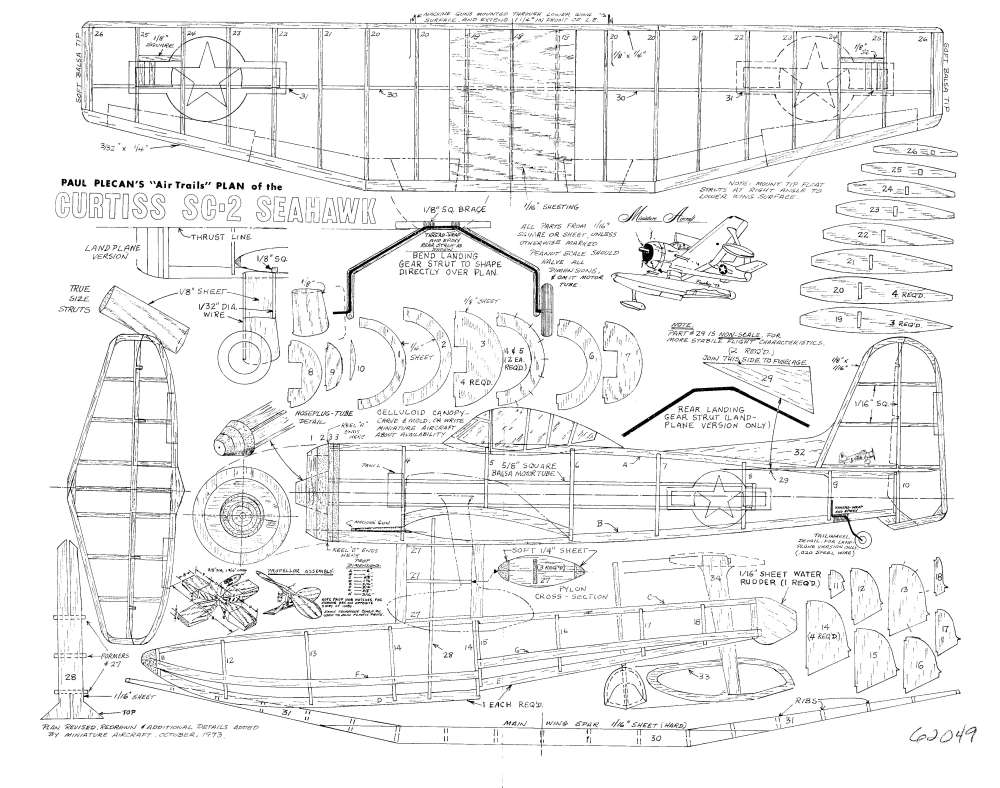
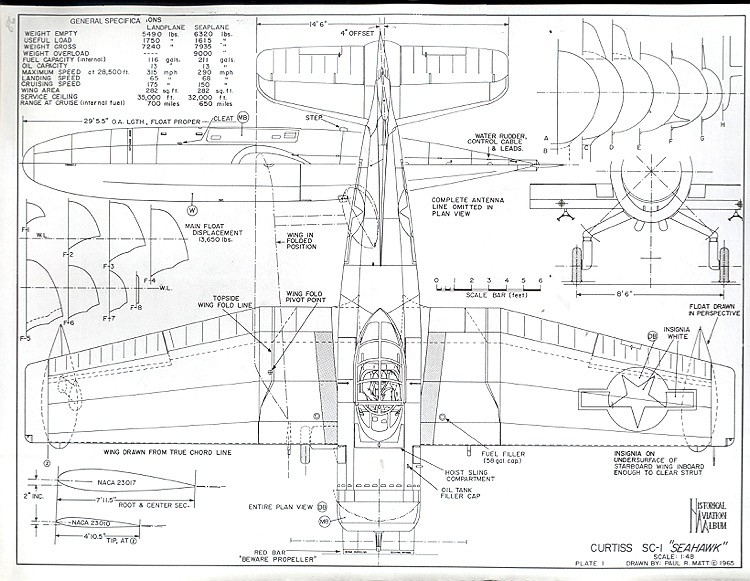
The SC was of course of all metal construction, aluminium with some steel insterts and in general of a cantilever low wing monoplane design, with dihedral on the outer wings panel plus a straight leading edge, tapered trailing edge. These winds had been well refined in wind tunnel for maximal efficiency and had the better profile ever for this type. Of coouse to facilitate storage, they were foldable to reduce storage space. They used the same “sto-bar” system as on Grumman models, and layed aside the fuselage instead of over it to keep the overall height low as well, as the main float was not retractable.
While only designed with the single seat, engineers found a way to install a bunk in the aft fuselage, for rescue or personnel transfer so it could be used for fast liaison between ships as well, albeit not in “VIP” conditions. As a floatplane its single central float was intened to bear the brunt of water landings and keep the engine high enough above the water spray. Part of its underbelly also ensured a cone of waterspray interrupted where the propeller was. All was calculated to as little seawater ingestion as possible. The quad propeller also participated in this, unlike the two-bladed prop of the previous Seamew. This was compounded with the compact design of the engine, far removed from the tip of the float. The wing tip stabilisers were also a clever innovation. The landing gear could be also removed and a classic wheeltrain installed with ease, making it convertible for landbase use. Engineers also took care as packing as many extra fuel as possible for extra range, and the float was in large part a fuel tank, with a pump to feed the engine.
Engine and Performances
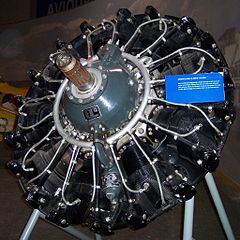 The prototype was powered by the Wright R-1820-82 Cyclone 9 radial engine, designed with the company as a wartime standard, to be as simple to produce as possible for mass production and easy maintenance. This ensure a large number will be be built and allocated, not only to the Seahawk, but also the B-17 Flying Fortress, Curtiss P-36 Hawk, Douglas B-18 Bolo, DC-3 and SBD Dauntless as well as the General Motors FM-2 Wildcat, the late version of the Grumman fighter.
The prototype was powered by the Wright R-1820-82 Cyclone 9 radial engine, designed with the company as a wartime standard, to be as simple to produce as possible for mass production and easy maintenance. This ensure a large number will be be built and allocated, not only to the Seahawk, but also the B-17 Flying Fortress, Curtiss P-36 Hawk, Douglas B-18 Bolo, DC-3 and SBD Dauntless as well as the General Motors FM-2 Wildcat, the late version of the Grumman fighter.
The “Cyclone 9” was a further development of the 1925 Wright P-2 engine with greater displacement and many improvements, starting its service from 1931 and remaining in production into the 1950s, quite an achievement for any aero engine !
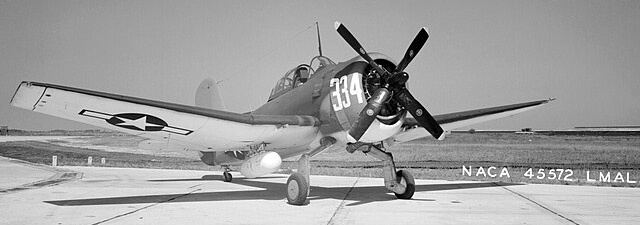
SC-1 with undercarriage undergoing NACA tests in 1945
It was also built under license by Lycoming, Pratt & Whitney Canada, and Studebaker in WW2, while the USSR had it licenced as the Shvetsov OKB and later the M-25, or in Spain as the Hispano-Suiza 9V. This great powerplant made the days of Douglas, powering its DC-1, DC-2, DC-3, and DC-5 whereas it did wonders for the war-winning SBD Dauntless, or even the postwar Piasecki H-21 helicopter.
Or even in tanks with the diesel variant G-200 on the M6 Heavy Tank… Output grew from R-1820-04 and its 700 hp (520 kW) to the R-1820-103 delivering twice as much, 1,425 hp (1,063 kW). The SC -62 variant was in a higher tier at 1,350 hp (1,010 kW), which combined to 4-bladed constant-speed propeller and 9,000 lb (4,082 kg) gross weight did wonders:
With a top speed of 313 mph (504 km/h, 272 kn) at 28,600 ft (8,700 m), 125 mph (201 km/h, 109 kn) when cruising, for a Range of 625 mi (1,006 km, 543 nmi) (not ferry range, only back and forth trip from the launching ship), while ceiling was excellent at 37,300 ft (11,400 m), reached with a blasting 2,500 ft/min (13 m/s). Range was not brillant, but this new model was not intended for long range reconnaissance anyway, just recoignizing ships picked up by radar, using its own radar for extra range, and artillery spotting at battle range.
To compare the Kingfisher reached a meager 18,200 ft (5,500 m) at snail paced of 960 ft/min (4.9 m/s) at 4,000 ft (1,219 m). That was light and day for the Navy, something never seen in that category.
Armament and Equipments

SC-1 on catapult, src 1000aircraftphotos.com
The SC had in serie two wing-mounted .50 in (12.70 mm) M2 Browning machine guns, supplied by ammunition belts ensuring attack capabilities. After all, the similarly armed Dauntless was proved able to shoot down enemy planes at many occasions.
As for bombs, its two 325 lb (147 kg) under-wing models were located close to the fuselage in the non-folding straight section (or depth charges), but in reality they are never seen on photos suggesting seldom used. It was requested by the navy anyway for attack missions in supplement to carrier-based models and indeed the Kingfisher often performed such attacks during many operations, while those in the Atlantic delivered depht charges on surfaced U-Boats at many occasions.
Initially the two underwing hardpoints were not present. The frist prototypes and pre-production models had a main float designed to incorporate a bomb bay. But on trials it suffered substantial leaks and soonwas modified to carry an auxiliary fuel tank, completely sealed off.
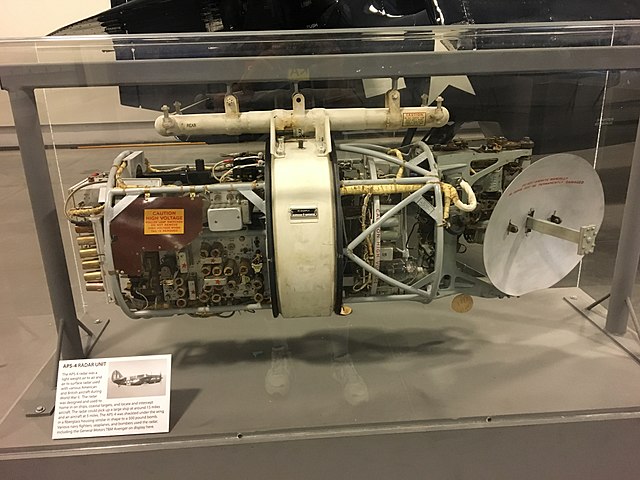
Also as payload, the SC carried under its right wing its surface-scan radar, which was however, a permanent fixture showed on all photos.
This APS-4 radar pod was a British creation. Known as the ASH (air-surface, model H) this early military AA/AS radar was used by many allied warplanes during World War II. It operated in the X band at 3 cm allowing the antenna to be greatly reduced and fit into a small streamlined, mounted on many aircraft. Notably the USN F4U-2\5N Corsair, Grumman F6F-3/5 Hellcat, Curtiss SB2C-5 Helldiver and Grumman TBF-3 and TBM-3S Avenger. It was logical that it found its way on the SC as well, the first USN floatplane to do so.
Frequency: 3300 ±50 MHz (S-band), PRF 660 pps
Beamwidth ~10º horizontal, ~15º vertical; Pulsewidth 1 μs, RPM 60 rpm
Range: 1 to 100 mi (1.6–160.9 km) (power 40 kW)
The pod was 28 in (0.71 m) in diameter, for a azimuth of 320º, a precision of ~5º
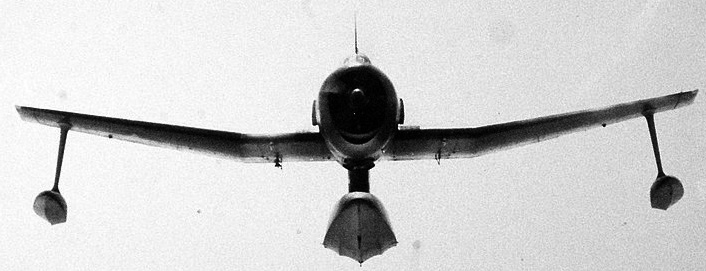
⚙ Curtiss SC specs. |
|
| Empty Weight | 6,320 lb (2,867 kg) |
| Gross Weight | 9,000 lb (4,082 kg) |
| Lenght | 36 ft 4.5 in x 41 ft x 16 ft (11.087 x 12.50 x 4.88 m) |
| Wingspan | 36 ft 4.5 in x 41 ft x 16 ft (11.087 x 12.50 x 4.88 m) |
| Height | 36 ft 4.5 in x 41 ft x 16 ft (11.087 x 12.50 x 4.88 m) |
| Wing Area | 280 sq ft (26 m2), Airfoil: root: NACA 23017; tip: NACA 23010 |
| Engine | Wright R-1820-62 Cyclone 9-cyl. 1,350 hp (1,010 kW) 4-bladed CS propeller |
| Top Speed, sea level | 313 mph (504 km/h, 272 kn) at 28,600 ft (8,700 m) |
| Cruise Speed | 125 mph (201 km/h, 109 kn) |
| Range | 625 mi (1,006 km, 543 nmi) |
| Climb Rate | 2,500 ft/min (13 m/s) |
| Ceiling | 37,300 ft (11,400 m) |
| Armament | 2× .50 in M2 Browning HMG, 2× 325 lb (147 kg) bombs underwing |
| Crew | 1: Pilot |
Variants

A U.S. Navy Curtiss SC-2 Seahawk (BuNo 119529) at Naval Air Station Patuxent River, Maryland (USA), 23 September 1947.
Operational History
The first serial production Seahawks arrived for deliveru to their squadrons on 22 October 1944, and the Alaska class “large cruiser” USS Guam was in October, apparently the first to have them when completed. Part of the order were delivered on conventional landing gear, and flown to the Naval Air Stations when float models had been all derlivered to their respective, numerous cruisers and battleships in operations. The land-based SC were not operable from aircraft carriers however. Capable of being fitted with either float or wheeled landing gear, the Seahawk was arguably America’s best floatplane scout of World War II. However, its protracted development time meant it arrived quite late. Despite of this, it was liked by many, pilots and ships crews alike. It was generally well accepted as capable of out-climbing an F6F “Hellcat” to 6,000 ft and out-turn the F8F “Bearcat” which were no small feats !
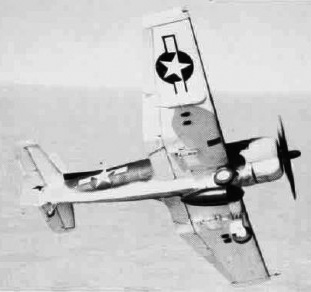 Crews looked at them with pleasure on catapults, dubbed as their “Quarterdeck Messerschmitts”.
Crews looked at them with pleasure on catapults, dubbed as their “Quarterdeck Messerschmitts”.
But despite of this losses were high, mostly due to extremely hazardous conditions of operations. When the landing was hard enough, it happened often that the propeller cut through the float (causing it to loose buocyancy and sink). Mishaps occurred due to a faulty auto-pilot system as well, and many lost due to unknown landing accidents, that is until one pilot discovered that the auto-pilot was taking over on landings and soon, word was passed on to remove all automatic pilot systems. The radar pod proved also more fragile on these planes than on carrier-based ones.
The Seahawk entered service also on USS Savannah (CL-42) obtained while in Chesapeake Bay in September 1944, and three SC-1s from VCS-8 in late 1945.
In July 1944 USS Iowa (BB-81) transferred her own SC-1s on USS Chicago (CA-136) for spotting duties for Japanese home islands attacks. USS Columbia (CL-56) received three SC-1s during her overhaul in early 1945. USS Pennsylvania (BB-38) had two used for the bombardment of Wake Island of 1 August 1945, but one was lost when landing in heavy seas. postwar, it was still in use on USS Iowa (BB-61) (1947), USS Missouri (BB-63) (1948), USS Columbus (CA-74) (1948) among others. In late 1948 however it was probably retired. The last still present in several Naval Stations were removed in turn in 1949 when it was officially declared obsolete.
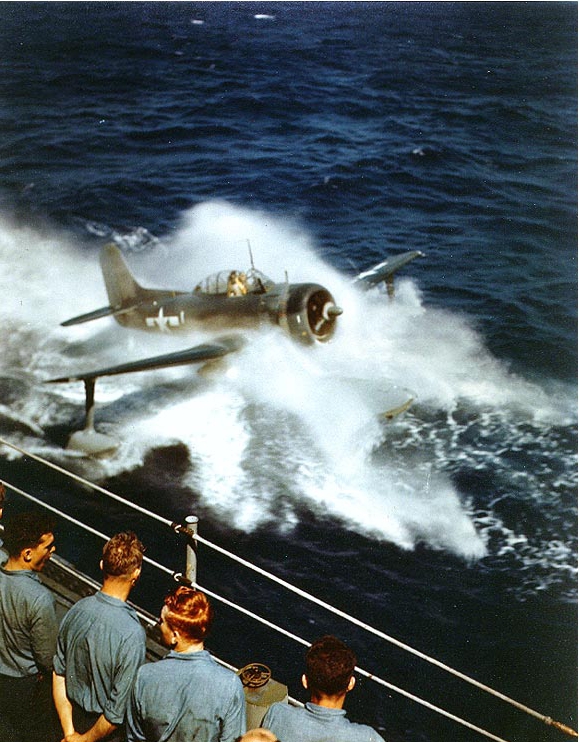
In general, the SC entered service too late to make an impression. Seahawks saw action essentially during the battle of Okinawa. In June 1945 pre-invasion bombardment of Borneo was the first time the Seahawk was involved in large numbers. In 1946, they remained in service but rapid progresses in radar had them soon questioned in their utility. In 1947-48 they started to be replaced by helicopters. They procured immenses advantages compared to seaplanes, notably the whole procedure of recovering a seaplane from the water, and preparing it for a launch on a catapult were dispensed of. Payload was greater also, flexibility as well. All traded for speed and range.
Unfortunately for aviation enthusiasts out here, there are no known surviving examples of the Seahawk today, only photos. This model is a bit fogotten today in part because of this and its’s a shame. Objectively this was the best ship-based seaplane ever designed, and probably worlwide, ever. It certainly restored some reputation for Curtiss, but it was overshadowed by the rest of its production anyway. It seems postwar Curtiss competed for many more designs, obtaining at least juicy prototyping contracts but never came back in full light with a significant model. The Seahwak was its twilight model, its last single-engine float plane, and last hurrah in the history of aviation.
Gallery
Illustrations
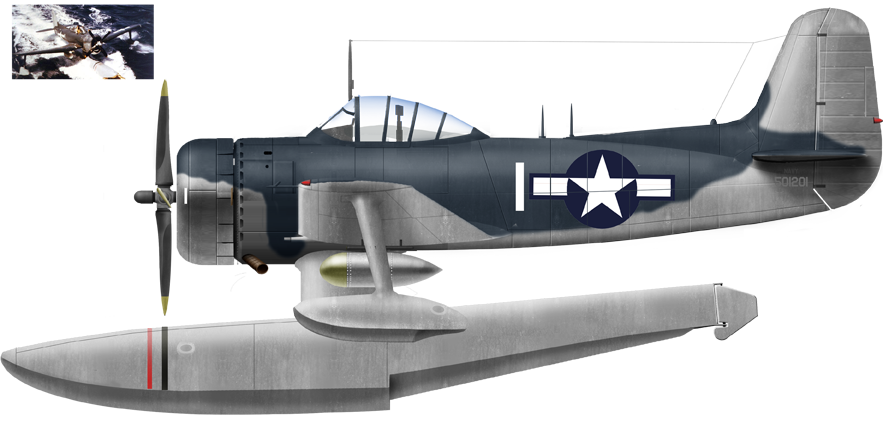
SC-1 USS Alaska, March 1945
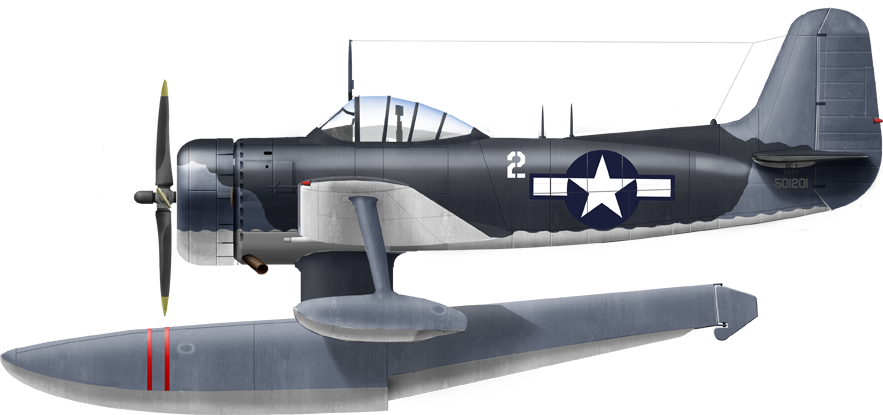
SC-1 VCS16, USS Birmingham CL-62 1945

SC-1 VO1b, USS Iowa, 1948
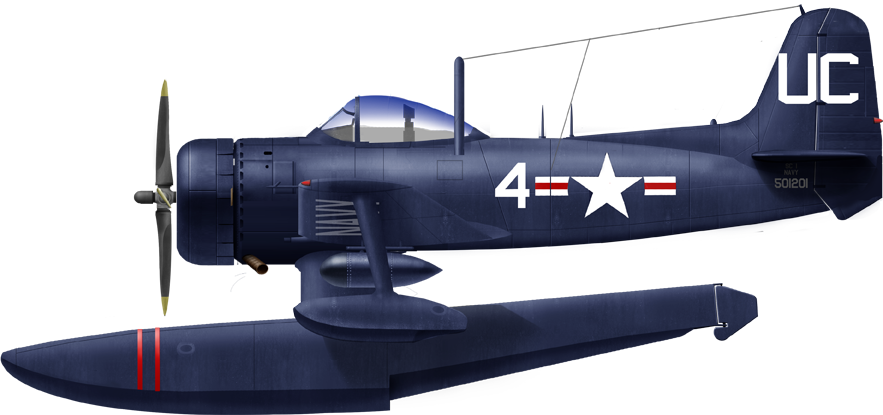
SC-2 VU3 USS Missouri 1948
Photos
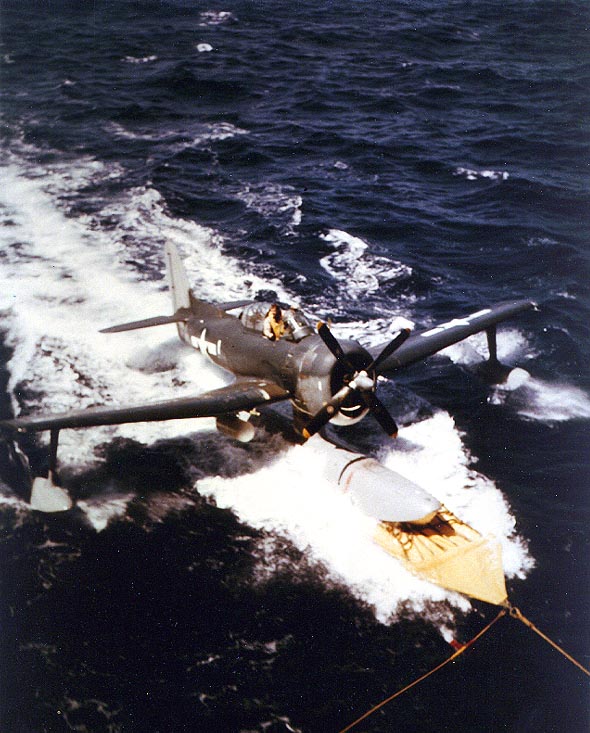
Curtiss SC Seahawk being recovered by USS Alaska after climbing on the landing mat, awaiting pickup by the ship’s crane. This model was piloted by Lieutenant Jess R. Faulconer, Jr., USNR. 6 March 1945 (cc)

On land

with undercarriage

From ONI

catapulted from USS California
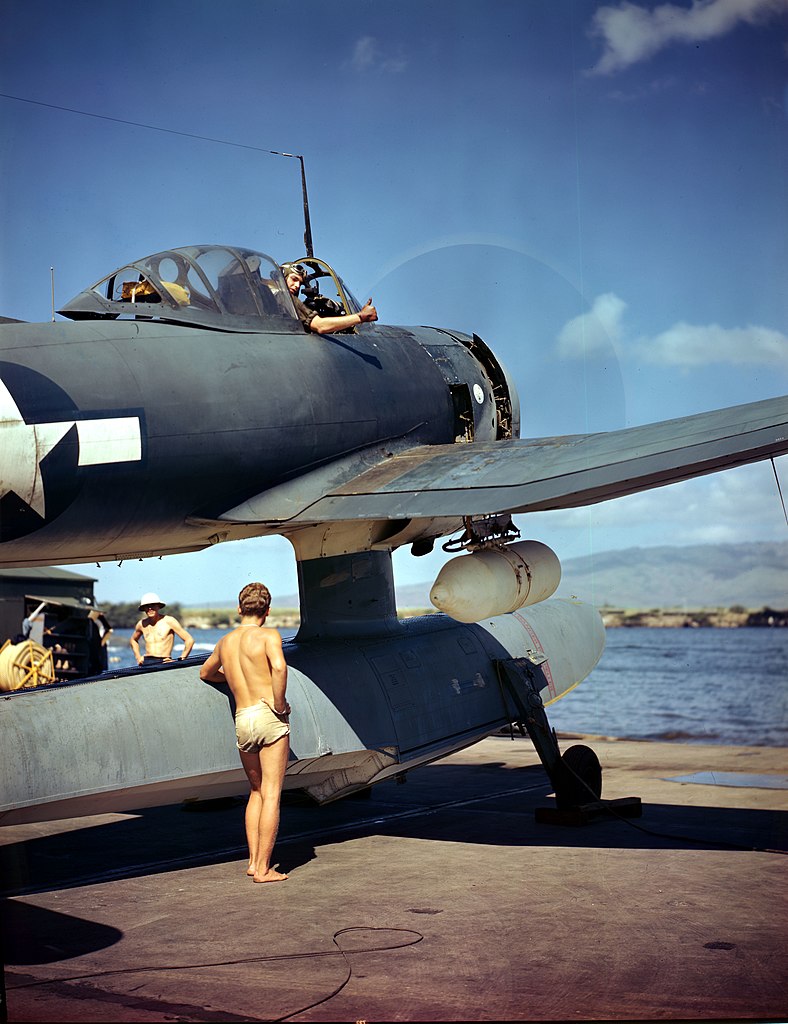
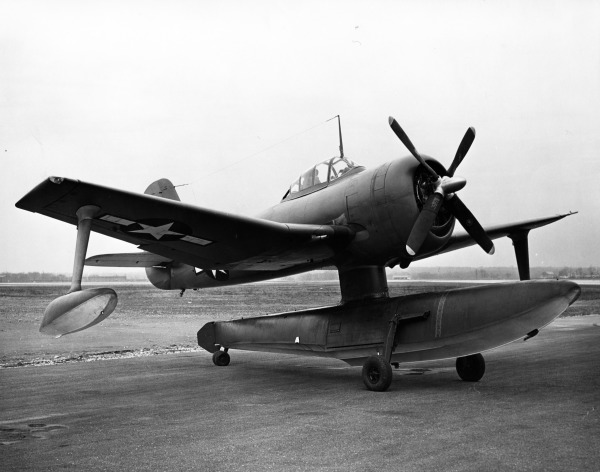

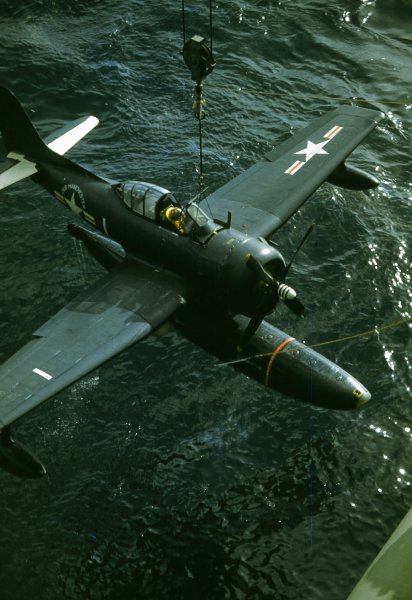
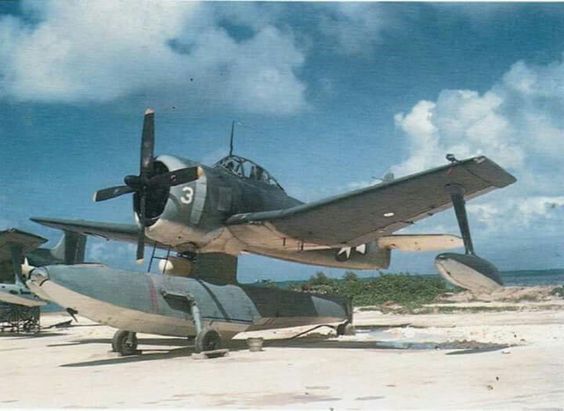
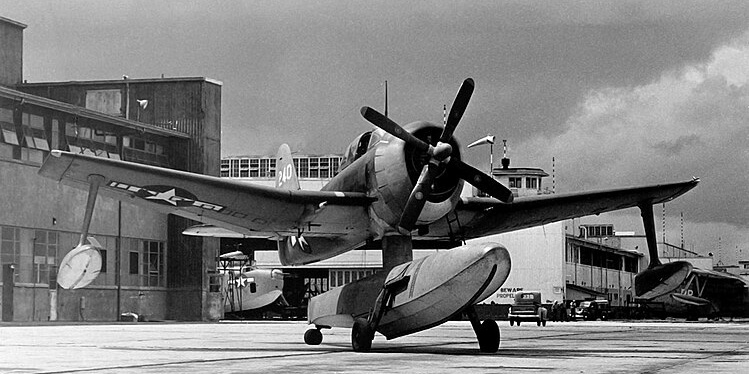
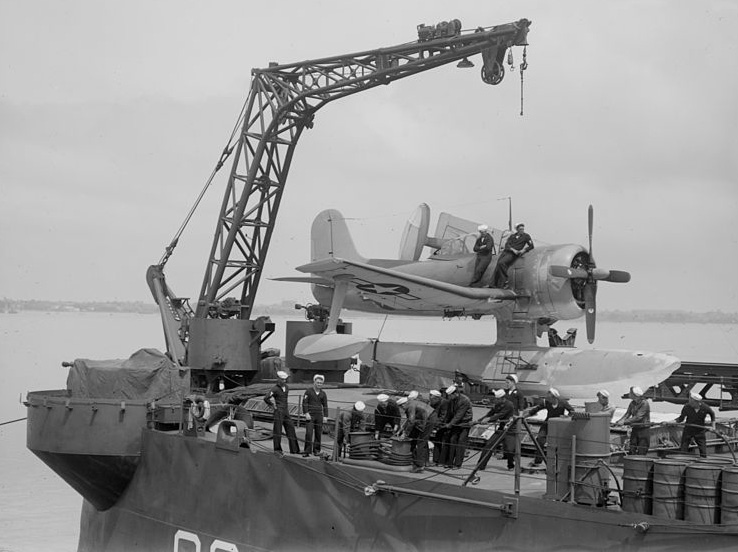
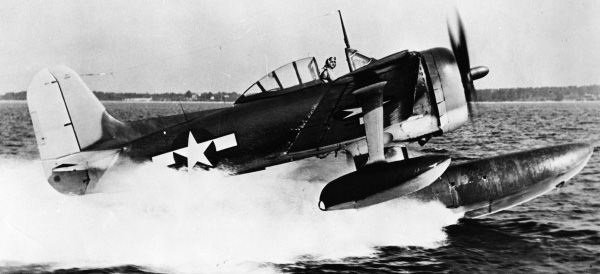
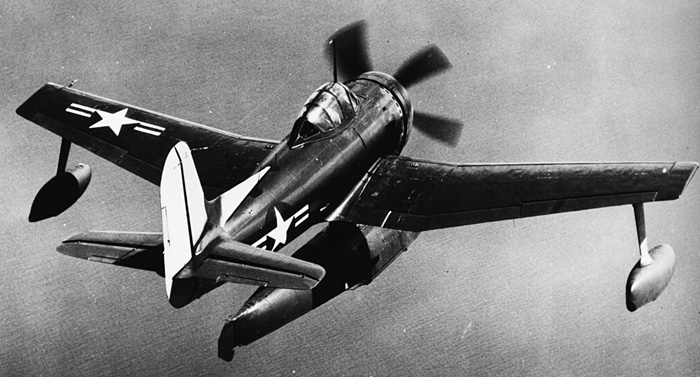
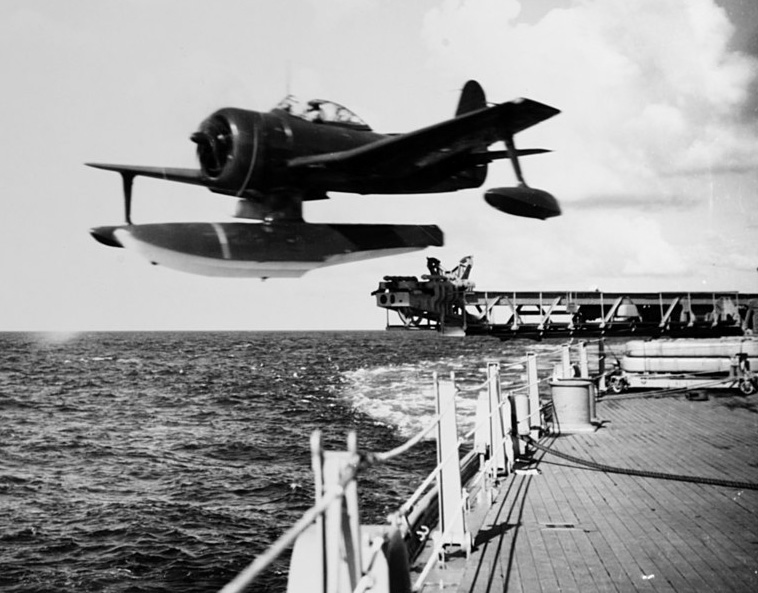
Read More/Src
Books
Bowers, Peter M. Curtiss Aircraft 1907–1947. London: Putnam, 1979. ISBN 0-370-10029-8.
Bridgeman, Leonard. “The Curtiss Seahawk”. Jane’s Fighting Aircraft of World War II. London: Studio, 1946.
Green, William. War Planes of the Second World War: Volume Six: Floatplanes. London: Macdonald, 1962.
Mondey, David. American Aircraft of World War II (Hamlyn Concise Guide). London: Bounty Books, 2006.
Swanborough, Gordon and Peter M. Bowers. United States Navy Aircraft since 1911. London: Putnam, Second Edition 1976.
Links
aahs-online.org/images/Navy_SAC/SC-1.pdf
aahs-online.org/images/Navy_SAC/SC-2.pdf
On popsci
on navsource.org/ 57k2.htm
on usslittlerock.org/
on militaryfactory.com/
on historyofwar.org/
on planehistoria.com/
on en.wikipedia.org/
commons.wikimedia.org/s

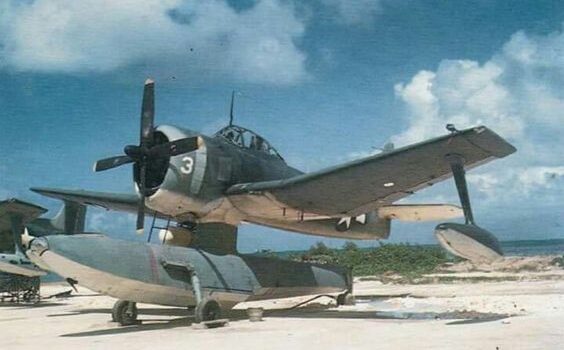
 Latest Facebook Entry -
Latest Facebook Entry -  X(Tweeter) Naval Encyclopedia's deck archive
X(Tweeter) Naval Encyclopedia's deck archive Instagram (@navalencyc)
Instagram (@navalencyc)





 French Navy
French Navy Royal Navy
Royal Navy Russian Navy
Russian Navy Armada Espanola
Armada Espanola Austrian Navy
Austrian Navy K.u.K. Kriegsmarine
K.u.K. Kriegsmarine Dansk Marine
Dansk Marine Nautiko Hellenon
Nautiko Hellenon Koninklije Marine 1870
Koninklije Marine 1870 Marinha do Brasil
Marinha do Brasil Osmanlı Donanması
Osmanlı Donanması Marina Do Peru
Marina Do Peru Marinha do Portugal
Marinha do Portugal Regia Marina 1870
Regia Marina 1870 Nihhon Kaigun 1870
Nihhon Kaigun 1870 Preußische Marine 1870
Preußische Marine 1870 Russkiy Flot 1870
Russkiy Flot 1870 Svenska marinen
Svenska marinen Søværnet
Søværnet Union Navy
Union Navy Confederate Navy
Confederate Navy Armada de Argentina
Armada de Argentina Imperial Chinese Navy
Imperial Chinese Navy Marinha do Portugal
Marinha do Portugal Mexico
Mexico Kaiserliche Marine
Kaiserliche Marine 1898 US Navy
1898 US Navy Sovietskiy Flot
Sovietskiy Flot Royal Canadian Navy
Royal Canadian Navy Royal Australian Navy
Royal Australian Navy RNZN Fleet
RNZN Fleet Chinese Navy 1937
Chinese Navy 1937 Kriegsmarine
Kriegsmarine Chilean Navy
Chilean Navy Danish Navy
Danish Navy Finnish Navy
Finnish Navy Hellenic Navy
Hellenic Navy Polish Navy
Polish Navy Romanian Navy
Romanian Navy Turkish Navy
Turkish Navy Royal Yugoslav Navy
Royal Yugoslav Navy Royal Thai Navy
Royal Thai Navy Minor Navies
Minor Navies Albania
Albania Austria
Austria Belgium
Belgium Columbia
Columbia Costa Rica
Costa Rica Cuba
Cuba Czechoslovakia
Czechoslovakia Dominican Republic
Dominican Republic Haiti
Haiti Hungary
Hungary Honduras
Honduras Estonia
Estonia Iceland
Iceland Eire
Eire Equador
Equador Iran
Iran Iraq
Iraq Latvia
Latvia Liberia
Liberia Lithuania
Lithuania Mandchukuo
Mandchukuo Morocco
Morocco Nicaragua
Nicaragua Persia
Persia San Salvador
San Salvador Sarawak
Sarawak Uruguay
Uruguay Venezuela
Venezuela Zanzibar
Zanzibar Warsaw Pact Navies
Warsaw Pact Navies Bulgaria
Bulgaria Hungary
Hungary

 Bundesmarine
Bundesmarine Dutch Navy
Dutch Navy Hellenic Navy
Hellenic Navy Marina Militare
Marina Militare Yugoslav Navy
Yugoslav Navy Chinese Navy
Chinese Navy Indian Navy
Indian Navy Indonesian Navy
Indonesian Navy JMSDF
JMSDF North Korean Navy
North Korean Navy Pakistani Navy
Pakistani Navy Philippines Navy
Philippines Navy ROKN
ROKN Rep. of Singapore Navy
Rep. of Singapore Navy Taiwanese Navy
Taiwanese Navy IDF Navy
IDF Navy Saudi Navy
Saudi Navy Royal New Zealand Navy
Royal New Zealand Navy Egyptian Navy
Egyptian Navy South African Navy
South African Navy






























 Ukrainian Navy
Ukrainian Navy dbodesign
dbodesign
Dad was the senior aviator on the. Chicago. The flew spotter during the shelling of Japan. I believe I have a retractable reel that was used to deploy an antenna to improve long range communication. We use it for kites since I was very young (now 72). Dad said that it was also used to improve water landing in poor visibility. They determined the “sag” of the training wire. As they started to land, when the antenna touched the water it shorted out the antenna connection. With the shorting of the wire, the could accurately determine how close to surface water aiding in setup for water touchdown.
Thanks for the history. Wish dad was still here to comment.
Thanks for your highlight and personal connection Anthony, much appreciated !